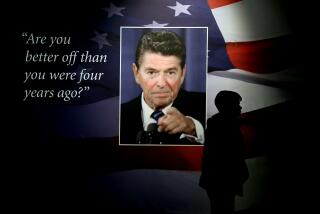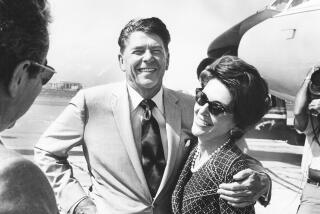Inside Reagan’s bid for detente
- Share via
The author of this book is a retired Foreign Service officer, specializing in Soviet affairs. He holds a master’s degree from Columbia in this subject and has served four tours of duty in Moscow, the last, from 1987 to 1991, as U.S. ambassador. He was thus in a unique position to observe firsthand the evolution of American-Soviet relations from intense hostility to gradual thaw, culminating in the dissolution of the Soviet Union that ended the Cold War. Having described the last phases of this historic process in his 1997 book, “Autopsy on an Empire: The American Ambassador’s Account of the Collapse of the Soviet Union,” Jack F. Matlock Jr. now focuses on the years immediately preceding the collapse of the USSR (1983 to ‘87) when he occupied the post of director for European and Soviet Affairs in President Reagan’s National Security Council.
When Ronald Reagan moved into the White House, I served as Soviet specialist in the National Security Council while Matlock was charge in the Moscow embassy. I recall being impressed by his dispatches, which displayed a realistic grasp of Soviet behavior, quite different from that prevalent in the State Department. But Matlock soon transferred from Moscow to the embassy in Prague and thus found himself removed from the day-to-day course of relations between Washington and Moscow.
This absence accounts for his rather misleading picture of Reagan’s Soviet policies in the first two years of his presidency. Matlock minimizes Reagan’s visceral hostility toward communism and the USSR, depicting him as someone consumed with the desire to negotiate with Moscow. In fact, as I can testify from personal experience, during this period Reagan was determined not to negotiate with the Soviet leadership. He was convinced -- not quite correctly -- that in negotiations with the Soviets, the United States had made all the concessions, and he insisted on getting some concrete quid pro quo from them before resuming diplomatic talks.
I was present at a meeting in March 1983 between the president and Secretary of State George Shultz when the latter, ignoring National Security Decision Directive 75, which the president had signed only two months earlier and which called for the U.S. to use all means at its disposal to try to change the Soviet system, urged him to engage in talks with Moscow. Reagan listened to him with growing impatience and then testily replied, “It seems to me that in the previous years of detente we always took steps and got kicked in the teeth.” It was up to the Russians to take the initiative. And indeed, soon after they had done so under Mikhail Gorbachev, Reagan extended to them a hand of friendship.
Matlock also misconstrues Reagan’s relationship with his first secretary of State, Alexander Haig, which he could observe only from a distance, by portraying it as a political partnership. In fact, their association was one of unremitting tension caused partly by Haig’s distaste for Reagan’s ideological antagonism to Moscow and partly by his insistence on running foreign policy. The tension led to Haig’s dismissal before Reagan’s first term was halfway through.
Friction between the White House and Foggy Bottom in the early phases of Reagan’s presidency was a constant. The State Department resembles a gigantic firm of international lawyers who perceive their mission to be the elimination of all conflicts through negotiation. Refusal to engage in talks, let alone resorting to force, is to them a mark of failure. Viewing themselves as consummate pragmatists, they intensely dislike anything that smacks of ideology.
Now, negotiations are a fine thing, provided that the parties to them agree on fundamentals, the most basic of which is recognition of one another’s right to exist. Where this recognition is absent, negotiations are an exercise in futility. Such is the case in the Middle East, where the Arabs continue to reject Israel on the grounds that it occupies Palestinian territory and hence has no right to be.
Since seizing power in 1917, the Soviet government proceeded on the premise that all capitalist regimes were doomed. Every treaty with these regimes was, therefore, an armistice in force only as long as Moscow found it convenient. Reagan sensed this and felt that it was his duty, by word and deed, to convince Moscow it had no chance of relegating the United States to the “dustbin of history.” Once it had reached this conclusion and demonstrated it by making concessions, no matter how small, he was quite prepared to negotiate with it. But not before.
Matlock’s account, flawed in the opening two chapters when he was away from the scene of the action, becomes authoritative after mid-1983 when, having reluctantly given up his ambassadorship in Prague, he moved into the White House. He came at an opportune time, when the ice in U.S.-Soviet relations began to melt. He does not discuss the reasons for this thaw, but it seems to have been brought about by a war scare that occurred in November 1983 as the result of a NATO war exercise code-named Able Archer, which the Russians misinterpreted as preparation for a nuclear strike on their territory.
The scare persuaded Reagan to soften somewhat his anti-communist rhetoric but not to suspend aid to Polish Solidarity or to cease pressuring the Saudis to increase their oil output, which lowered world oil prices with devastating consequences for Soviet hard-currency earnings. These policies are not discussed in “Reagan and Gorbachev.” Surprisingly, the name of Pope John Paul II, a vital link with Solidarity, does not figure in the index.
The real break came in March 1985 with the election of Gorbachev as head of the Soviet Communist Party and thus, de facto, chief executive of the Soviet Union and its bloc. Reagan at first reacted cautiously to this change but, trusting his impressions of the new leader following several personal encounters, gradually gained confidence in him.
The most engrossing sections of Matlock’s book deal with the summit in Reykjavik, Iceland, in October 1986. Reagan was widely blamed for rejecting Gorbachev’s offer to eliminate all strategic nuclear weapons in exchange for the United States’ giving up testing missile defenses, Reagan’s pet project. Although Western scientists ridiculed Reagan’s Strategic Defense Initiative as “Star Wars” and continue to dismiss President Bush’s efforts in the same direction, the Russians, with their unbounded faith in American technology, took them very seriously, so seriously that they were willing to surrender their vast strategic nuclear arsenal if SDI testing was abandoned. Reagan refused to accept the deal, so the summit broke up without result.
Matlock defends the president on this issue. An active participant in these events, he insists that Reagan was fully cognizant of what was at stake and then goes on to explain how tenuous Gorbachev’s offer really was:
“Those who have accused Reagan of passing up a unique opportunity to rid the world of nuclear weapons must assume that, once there had been broad agreement in principle, a treaty would have been forthcoming -- automatically as it were -- and that this treaty would have been ratified by the legislatures of both countries and then faithfully implemented.... Nothing in the history of U.S.-Soviet relations up to then would have provided any encouragement for such expectations.... The program in its entirety was too ambitious to be practical.”
In writing this book, Matlock relied heavily on his diaries and notes. This procedure has its virtues and shortcomings. On the negative side, it tends to ignore personalities and ambience. The two protagonists of his narrative never really come to life: They are abstractions that speak, write and negotiate. Although both Reagan and Gorbachev had lively personalities, they remain shadowy figures, performers on the stage of history rather than human beings in their own right. At the same time, this technique makes for a detailed and reliable narrative that future historians will be able to draw on to illuminate one of the most dramatic periods in modern history. *
More to Read
Sign up for Essential California
The most important California stories and recommendations in your inbox every morning.
You may occasionally receive promotional content from the Los Angeles Times.










